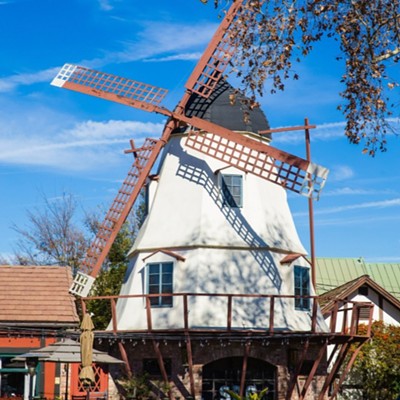The largest proposed housing development in San Luis Obispo County in 25 years would cut down close to 4,000 oak trees, disrupt protected plant and wildlife species, and strain local traffic, among other impacts, according to a draft environmental impact report (EIR) released last month for the Dana Reserve in Nipomo.
The 1,289 single- and multi-family units envisioned as part of the Dana Reserve project are being welcomed by SLO County and some community groups as a much-needed injection of housing supply into the local market, while critics are calling it overly ambitious and environmentally destructive.

First proposed by local development firm NKT Commercial in 2020, Dana Reserve looks to build on a 288-acre site south of Willow Road and west of Highway 101 known as Cañada Ranch. The property has been slated for development for more than a decade, but prior plans never materialized.
While past plans for Cañada Ranch concentrated on commercial uses to address Nipomo’s jobs/housing imbalance, the Dana Reserve focuses on housing—its hundreds of proposed single- and multi-family units would span 10 neighborhoods and include a park, hiking and equestrian trails, and some commercial development.
According to SLO County Planning Manager Airlin Singewald, the local and statewide housing shortage caused planners and NKT Commercial to pivot away from the ranch’s prior top development priorities of “open spaces uses within the oak woodlands” and “an industrial park for employment,” in favor of a denser, residentially focused project.
If approved, Dana Reserve would be the largest housing project to come to unincorporated SLO County since Nipomo’s last major development, Monarch Dunes, and its 1,320 units were approved in 1998, according to Singewald.
Dana Reserve’s draft EIR—which is open for public comment through Aug. 1 and will be the subject of an informational study session at a July 14 SLO County Planning Commission meeting—highlights seven “significant, unavoidable” impact areas from the project: in growth, population, transportation, land use, greenhouse gas emissions, biological resources, and air quality.
According to the EIR, Dana Reserve would cause the removal of about 75 acres of coast live oak woodland and oak forest on the ranch—close to 4,000 individual trees and about 76 percent of the oaks on the site. The woodland—which covers about 40 percent of the entire project area—“provides important native habitat for plants and wildlife” and “contributes significantly to … the region’s overall biological diversity,” supporting eight special-status plants and four special-status nesting birds.
NKT Commercial proposes to mitigate that loss of trees and habitat by dedicating a 388-acre, off-site parcel 2 miles east of the project for permanent conservation and saving about 20 acres of woodland/forest on the Cañada Ranch site. It also proposes to plant “anywhere from 1,500 to 3,000 oak trees” as mitigation. NKT will also have to earn a specific permit from SLO County to remove the trees as part of the county’s 5-year-old oak woodland ordinance.
But the EIR emphasizes that the project’s off-site conservation property does not contain the same special-status species that thrive on Cañada Ranch and adds that some mitigation efforts may not succeed. The EIR concludes that the project would cause “a significant net loss of oak trees and acreage of oak woodlands in the county.”
Other impacts identified in the EIR are tied to the population growth that would follow the development. The EIR states that the size and scope of Dana Reserve is not “specifically projected or planned for in local and regional county planning documents” and would “induce substantial unplanned population growth in the Nipomo area.” The ensuing impacts from that include higher levels of traffic, greenhouse gas emissions, a loss of rural visual character, and an exacerbation of the community’s jobs/housing imbalance.
One issue that’s not considered a significant and unavoidable impact is water supply. The Dana Reserve, if approved, would get annexed into the Nipomo Community Services District (CSD) territory, and the district would provide the project with water and wastewater services.
According to the EIR, the Nipomo CSD has sufficient water supply to serve the project: It has between 538 and 1,205 acre-feet per year of available water to serve areas outside of its current service boundary. Dana Reserve at full build-out would demand 387 acre-feet per year. According to a NKT Commercial presentation made to the Nipomo CSD in 2020, by the fiscal year 2025-26, the CSD will be “contractually required to increase the purchase of water from Santa Maria by an additional 700 acre-feet.” The developer argues that Dana Reserve’s eventual residents will help share the burden of those costs for all ratepayers.
NKT Commercial owner Nick Tompkins was not available for comment for this story. Public opinion on the project runs the gamut, with some residents and community groups applauding the addition of housing and others calling it too large and impactful.
Peoples’ Self-Help Housing, a nonprofit affordable housing developer that plans to partner with NKT to make one of the project’s 10 neighborhoods all-affordable, wrote in a 2021 comment letter that the project “meets the most critical needs for the community.”
Arroyo Grande resident Angie Mello also wrote to support the project, saying, “We need affordable family housing to both buy and rent. The Dana Reserve does this.” Mello praised the project’s hiking and biking trails, traffic improvements, and proposed integration of a satellite Cuesta College campus on-site.
“I am 100 percent positive that we need to do everything possible to make the Dana Reserve a reality,” Mello wrote.
But other local groups and residents registered their opposition to the project. In letters submitted last year ahead of the EIR, several environmental and civic groups, including ECOSLO, the League of Women Voters of SLO County, and the Coastal San Luis Resource Conservation District (RCD) expressed concerns about the project’s scope and its possible impact on wildlife, oak trees, and water.
Neil Havlik, a retired natural resources manger for the city of SLO, told the Sun following the release of the EIR that he’s highly skeptical of the mitigation measures proposed for the loss of the oak forest. He said that the off-site parcel offered for conservation is “a totally different environment” than Cañada Ranch, and noted “we’re still left with a net loss of all of those oak trees.”
“I’m very concerned as a natural resources person. It saddens me to see [the project is] moving along as it is,” Havlik said, adding that he supports a downsized project that integrates the oak woodland. “Do a smaller project and leave the oak trees alone.”
Reach Assistant Editor Peter Johnson from the Sun’s sister paper at [email protected].














